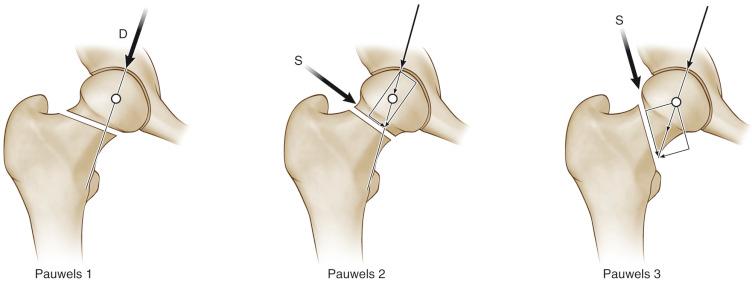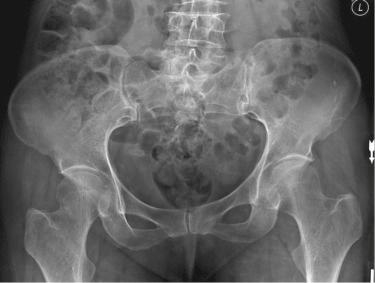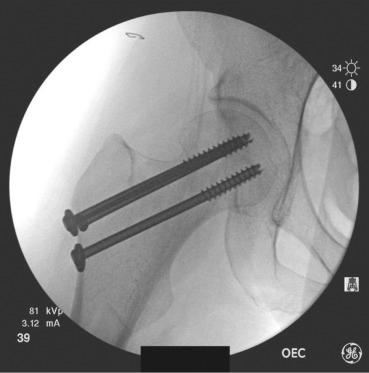Physical Address
304 North Cardinal St.
Dorchester Center, MA 02124
In the physiologically young and active adult, the goals of fixation are to preserve the femoral head, achieve union, and avoid osteonecrosis.
Open reduction and internal fixation (ORIF) through a single Watson-Jones anterolateral or a dual incision (Smith-Petersen and accessory) approach allows for full visualization and accurate reduction of the fracture.
Variables such as time to surgery, role of capsulotomy, and the method of fixation remain debatable.
Arthroplasty has demonstrated a 30% to 40% lower reoperation rate when compared with ORIF of a displaced femoral neck fracture in the elderly.
Total hip arthroplasty has demonstrated improved functional scores but higher dislocation rates when compared with hemiarthroplasty in the active elderly.
Cemented stems allow for fewer complications, less pain, and better functional outcomes but have increased operating room time and carry a hypotensive risk.
Uncemented stems may be faster and associated with less blood loss but have higher complication rates, dislocations, and early and/or late fractures.
Femoral neck fractures are common in the elderly population after a simple fall. However, femoral neck fractures in physiologically young adults are less common, representing approximately 5% of the total. These younger patients are active and usually have minimal medical problems and good bone quality. Femoral neck fracture in these young patients generally occurs after a motor vehicle accident or other high-energy mechanism. It is important to understand the osseous and vascular anatomy, mechanism of injury, associated injuries, the fracture pattern, and the goals of treatment. Although achieving anatomic reduction and stable internal fixation is imperative, other treatment variables—such as time to surgery, the role of capsulotomy, and fixation methods—are still being debated. Knowledge of treatment options and potential complications is beneficial in understanding and managing femoral neck fractures in young adults.
Femoral head blood supply comes from three main sources: the medial femoral circumflex artery (MFCA), the lateral femoral circumflex artery (LFCA), and the obturator artery. The largest contributor to the femoral head, especially the superolateral aspect of the femoral head, is the MFCA. The lateral epiphyseal artery complex originates from the MFCA and courses along the posterosuperior aspect of the femoral neck before supplying the femoral head. Terminal branches supplying the femoral head are intracapsular; thus, disruption or distortion of these terminal branches likely plays a significant role in the development of osteonecrosis. Variables that have been hypothesized as contributing to femoral head osteonecrosis include vascular damage from the initial femoral neck fracture, the quality of reduction or fixation of the fracture (restoring flow to the distorted arteries), elevated intracapsular pressure (tamponade from blood), and the position of the implants.
Poor bone density, multiple medical problems, and propensity to fall are major risk factors for a low-energy femoral neck fracture in elderly patients. In the physiologically young adult, the position of the femur and load applied dictates fracture characteristics. Commonly, a substantial axial load with the hip in an abducted position is the mechanism that will produce a displaced femoral neck fracture. Clinical evaluation of these patients should include a thorough trauma workup, as they frequently have other injuries. Diagnosis and treatment of femoral neck fractures in young adults should be done immediately after other life- and limb-threatening injuries are managed. Patients with displaced femoral neck fracture will have a shortened, flexed, and externally rotated lower extremity. For incomplete or nondisplaced fracture of the femoral neck, internal rotation of the limb and heel strike usually will produce pain in the hip and groin region.
Radiographic evaluation should include anteroposterior (AP) and lateral plain radiographs of the entire femur as well as an AP radiograph of the pelvis, with the addition of traction views if the pattern is difficult to discern. The fracture pattern seen in young adults is different than that of elderly patients. Elderly patients with poor bone quality or a low-energy injury usually sustain an intertrochanteric hip fracture or a subcapital femoral neck fracture. A transverse fracture pattern with impaction at the fracture site is common. In young adults with better bone quality, higher-energy mechanisms of injury usually cause a basicervical or more distal neck fracture. This occurs from an axially loaded, high-energy force onto an abducted hip. The fracture pattern has a tendency to be more vertically oriented and biomechanically more unstable. These characteristics have important implications for obtaining and maintaining stable fixation, both of which are necessary for healing to occur.
Despite known limitations, femoral neck fractures in elderly patients are frequently described using the Garden classification. In this age group, treatment is often based on whether the fracture is nondisplaced or impacted (grades I and II) or displaced (grades III and IV). The Garden classification is not as useful for describing femoral neck fractures in young adults. The Pauwels classification ( Fig. 43.1 ) is more descriptive for young adults with femoral neck fractures. The fracture pattern can indicate the relative stability of the fracture and can predict the difficulty of obtaining stable fixation. A femoral neck fracture line less than 30 degrees from the horizontal plane is a Pauwels type 1, one that has an angle with the horizontal between 30 and 50 degrees is a Pauwels type 2, and one that has an angle greater than 50 degrees is a Pauwels type. The type 1 femoral neck fracture has greater intrinsic stability. Type 3 femoral neck fractures, the least stable, are seen in young adults more frequently than in the elderly. Type 3 fracture patterns are more difficult to treat and are associated with increased risks of fixation failure, malunion, nonunion, and osteonecrosis, probably because of greater shear at the fracture site related to the vertical nature of the fracture line.

In general, patients younger than 65 years are considered “young” and those over 75 years old are considered “elderly.” Patients between 65 and 75 years of age are judged to be young or elderly based on their “physiologic” age. However, age is sometimes inconsequential, as there are certainly outliers. Those who are active and have high functional demands, have good bone quality, and have minimal medical problems are considered “young.” Those who have low functional demands (use assistive device for ambulation), chronic illness, or poor bone quality are considered “elderly.”
For the elderly patient, the primary goal is early mobilization and minimizing complications associated with prolonged bed rest. The patient's age and functional demands make preserving the femoral head less important. A hemiarthroplasty or a total hip replacement often accomplishes this best. Several recent prospective randomized trials have all favored arthroplasty over fixation in the elderly for displaced femoral neck fractures; hemiarthroplasty versus total hip arthroplasty (THA) remains controversial ( Table 43.1 ).
| Function | Pain | Complications | Revisions | Mortality Rate | |
|---|---|---|---|---|---|
| Ravikumar and Marsh | Arthroplasty | Arthroplasty | Arthroplasty | Arthroplasty | Equivalent |
| Davison et al. | Arthroplasty | Arthroplasty | ORIF | ||
| Parker et al. | Equivalent | Equivalent | Arthroplasty | Arthroplasty | Equivalent |
| Keating et al. | Arthroplasty | Arthroplasty | Equivalent | ||
| Frihagen et al. | Arthroplasty | Arthroplasty | Arthroplasty | Equivalent | |
| Parker et al. | Equivalent | Arthroplasty | Equivalent | ||
| Chammout et al. | Arthroplasty | Arthroplasty | Equivalent | ||
| Parker | Arthroplasty | Arthroplasty | Equivalent |
In the physiologically young and active adult, the goals are to preserve the femoral head, avoid osteonecrosis, and achieve union. Avoiding an arthroplasty is highly desirable. It is generally agreed that anatomic reduction with stable internal fixation is paramount for a good outcome. Nevertheless, other issues—such as closed versus open reduction, the role of capsulotomy, and time to surgery—remain controversial. Methods of fixation also are a variable, but this subject is less controversial.
Fracture pattern alone determines the treatment of nondisplaced fractures. These include both valgus impacted (Garden grade 1) and complete but nondisplaced (Garden grade 2) femoral neck fractures. They should be treated with internal fixation. Nonoperative management of nondisplaced femoral neck fractures is associated with higher complication rates and increased risk for displacement. Patients should be transferred carefully over to the fracture table to avoid further displacement of the femoral neck fracture. Internal fixation in situ with three cannulated cancellous screws ( Figs. 43.2 to 43.4 ), dynamic hip screw, or even locked plating are all reasonable techniques for these fractures. Patient selection for internal fixation can be more difficult with displaced fracture variants. Factors to consider when deciding whether to proceed with open reduction and internal fixation (ORIF) of displaced femoral neck fractures include the patient's chronologic and physiologic age, level of activity, bone quality, associated comorbidities, and fracture pattern and characteristics. Although multiple treatment algorithms have been used and published, the best protocol remains debatable. It is generally recommended that displaced femoral neck fractures in patients who are physiologically younger than 65 years should have an ORIF. Patients over the age of 75 years with low-energy injuries, poor bone quality, and displaced subcapital fracture patterns should be considered candidates for hemiarthroplasty or THA to avoid the higher rate of secondary operations. As for patients between the ages of 65 and 75 years, the trend in the treatment algorithm is to perform a THA, especially if they are active and have high functional demands.



Arthroplasty has been reported to have less revision surgery, more rapid mobilization, and better function. Bhandari and associates published a meta-analysis comparing internal fixation with arthroplasty (hemiarthroplasty, bipolar arthroplasty, and THA) for treatment of displaced femoral neck fractures. They reviewed 14 studies with a total of 1933 patients. They concluded that performing arthroplasty for displaced femoral neck fracture reduced the risk of secondary operation. Secondary operation after internal fixation was often a result of nonunion and avascular necrosis (AVN). However, infection rate, blood loss, and operative time were increased in the arthroplasty group. More recent randomized controlled trials by Blomfeldt and colleagues and Keating and coworkers also reported a decrease in reoperation rate with arthroplasty. Blomfeldt and colleagues evaluated outcomes at 4 years of mentally competent, relatively healthy elderly patients who underwent internal fixation or THA for displaced femoral neck fracture. The rate of reoperation was 47% for internal fixation and 4% for THA. Using the Charnley score and the EuroQol-5D (EQ-5D) index to assess hip function and health-related quality of life, respectively, investigators concluded that THA performed better. Keating and coworkers randomized 207 patients and compared reduction and fixation, bipolar hemiarthroplasty, and THA. They reported reoperation rates of 39% for the fixation group, 9% for the THA group, and 5% for the hemiarthroplasty group. Arthroplasty was found to have better functional outcomes as measured by a hip rating questionnaire and the EQ-5D index.
Hemiarthroplasty is the preferred treatment for low-functioning community or nursing home ambulatory patients. Performing hemiarthroplasty in more active, mobile, and independent-living older patients raises concerns for acetabular erosion as well as poor functional and pain ratings. Baker and coworkers randomized 81 active individuals to THA or hemiarthroplasty for displaced femoral neck fracture. At a mean follow-up of 3 years, fewer complications, improved walking distances, and a higher Oxford Hip Score were noted for the THA group. More than 60% of living patients in the hemiarthroplasty group showed acetabular erosion on radiographs. In another randomized controlled trial, Blomfeldt and associates compared bipolar hemiarthroplasty with THA for displaced femoral neck fracture in active and lucid patients. They showed that THA resulted in better hip function (Harris Hip Score) but no significant difference in the health quality-of-life measure between the two groups. In summary, evidence suggests that THA is the better treatment for displaced femoral neck fracture in the right patients. These include patients older than 65 years who are competent, active, and community ambulatory, or those with preexisting hip disease (e.g., osteoarthritis, rheumatoid arthritis).
The authors’ preferred treatment algorithm is to perform arthroplasty for patients older than 65 years with poor bone quality and a high degree of comminution. THA is preferred for patients who are community ambulators who are lucid, independent, and have a life expectancy greater than 5 years. Hemiarthroplasty is ideal for patients who are low-demand, minimal ambulators who have cognitive impairment and a short life expectancy. No evidence indicates superior function or durability of bipolar as compared with unipolar, and unipolar is more cost-effective. Cemented stems are recommended for patients with poor bone quality or low demand. The authors reserve uncemented stems for patients with good bone stock who have higher functional demands and are younger. Here, controversy between cemented and cementless stems continue as results exhibit lower periprosthetic fracture rates in the cemented stem population. Proponents of press-fit stems will argue that careful insertion with or without a prophylactic cable lowers fracture risk while removing the variables of prolonged operative time and hypotension associated with cementing.
Become a Clinical Tree membership for Full access and enjoy Unlimited articles
If you are a member. Log in here